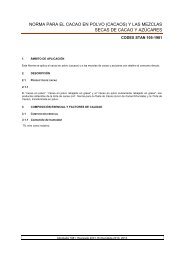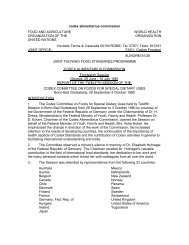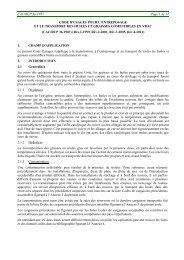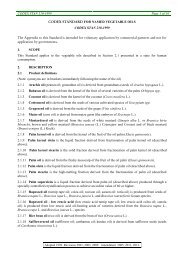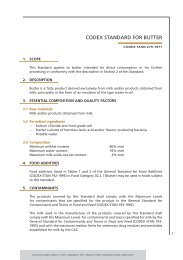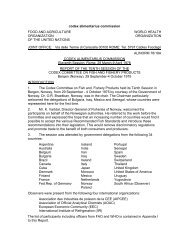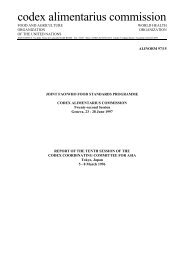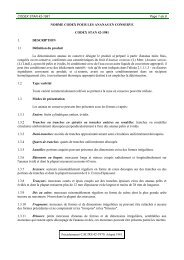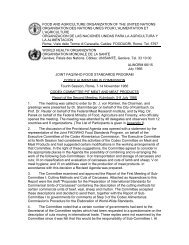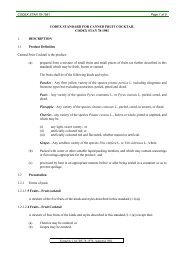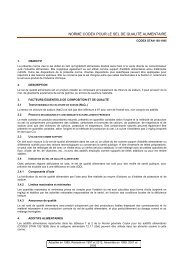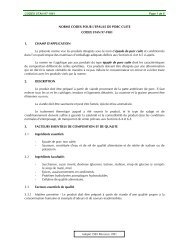REP13/FH JOINT FAO/WHO FOOD STANDARDS PROGRAMME ...
REP13/FH JOINT FAO/WHO FOOD STANDARDS PROGRAMME ...
REP13/FH JOINT FAO/WHO FOOD STANDARDS PROGRAMME ...
You also want an ePaper? Increase the reach of your titles
YUMPU automatically turns print PDFs into web optimized ePapers that Google loves.
<strong>REP13</strong>/<strong>FH</strong> Appendix IV 56<br />
5.1 Control of food hazards<br />
Prevention of contamination is a key control point for berries and packing establishments should pay special<br />
attention to product flow and segregation of incoming soiled and/or damaged and outgoing product to avoid<br />
cross-contamination.<br />
Care should be taken to ensure that berries are not damaged and do not become cross-contaminated during<br />
transport and handling. Prior to packing, berries that are soiled, come with debris (e.g., insects), or that are<br />
damaged, should be inspected and culled.<br />
Culled berries should be removed from the field or packing facility and disposed of to prevent contamination<br />
of other fruit. Culled fruit should be hygienically disposed of to avoid it from attracting pests.<br />
5.2 Key aspects of hygiene control systems<br />
5.2.2 Specific process steps<br />
5.2.2.1 Post-harvest water use<br />
Most berries intended for direct consumption are generally not washed after harvest.<br />
For berries that are washed, clean or preferably potable water should be used. It is recommended that the<br />
quality of the water used in packing establishments be controlled and monitored, i.e. recording testing for<br />
indicator organisms and/or foodborne pathogens.<br />
If water is used in pre-washing and washing tanks, additional controls (e.g. changing water whenever<br />
necessary and controlling of product throughput capacity) and monitoring (e.g. recording the pH and<br />
temperature, turbidity, and water hardness should be adopted.<br />
Water used for final rinses should be of potable quality.<br />
Any antimicrobial agents used in the water should be maintained at sufficient levels to ensure that water<br />
used in pre-washing and washing tanks does not act as a source of contamination for the fruit, and to<br />
prevent antimicrobial agents from damaging fruit skin structure.<br />
If antimicrobials and/or disinfectants are used to control foodborne pathogens in post-harvest water, the<br />
efficacy of the treatment should be demonstrated/validated against a target organism under appropriate<br />
conditions (see Section 5.2.3).<br />
5.2.3 Microbiological and other specifications<br />
Microbiological testing can be a useful tool to evaluate and verify safety and the effectiveness of cleaning<br />
practices and to provide information about an environment, a process, and even a specific product lot, when<br />
sampling plans and methodology are properly designed and performed. The intended use of information<br />
obtained (e.g. evaluating the effectiveness of a sanitation practice, evaluating the risk posed by a particular<br />
hazard, etc.) can aid in determining what microorganisms are most appropriate to test for. Test methods<br />
should be selected that are validated for the intended use. Consideration should be given to ensure proper<br />
design of a microbiological testing program. Trend analysis of testing data should be undertaken to evaluate<br />
the effectiveness of food safety control systems.<br />
5.2.4 Microbial cross-contamination<br />
Berries that have undergone cleaning and/or chemical treatment should be effectively separated, either<br />
physically or by time, from raw material and environmental contaminants.<br />
Prevent cross-contamination between raw and washed berries, which will be frozen, from sources such as<br />
wash water, rinse water, equipment, utensils and vehicles.<br />
Only workers who have been trained on hygienic handling should be assigned to pack berries.<br />
5.3 Incoming material requirements<br />
The following are recommended:<br />
For berries that are intended to be consumed raw as well as to be frozen, sorting and selection should<br />
be implemented to avoid using fruits that have visible signs of decay or damage due to the increased<br />
risk of microbial contamination.<br />
Berries should be cooled and stored as soon as possible under temperature controls within the<br />
processes.



